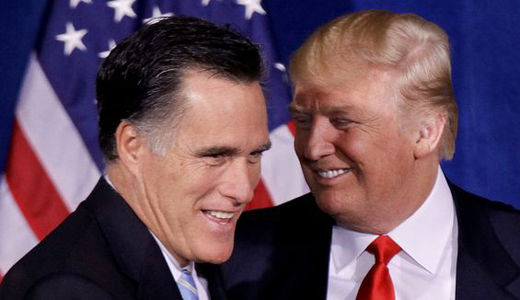
The meteoric rise of Donald Trump has become the biggest surprise of this election year. Not even the candidacy of a “democratic socialist” on the Democratic side comes close to commanding the same kind of public attention. And no one has been more caught off guard and thrown into a tailspin than the right-wing Republican establishment.
The prevailing assumption was that Trump’s star would quickly lose its luster. Voters infatuated by his persona would sour on him as they took closer measure of the man and deemed him not of presidential timber. But, to the surprise and dismay of the GOP establishment, the early infatuation gave way to an ongoing love affair.
Trump went from mild irritant to contending candidate to front-runner in the Republican presidential race. His toxic stew – demagogic, outrageous, divisive, brutish, misanthropic, paranoid, incendiary, violent, and narcissistic – has struck a deep nerve among a section of the electorate as it has frightened many others.
In handily winning so many recent primaries, in states as different as Massachusetts, Michigan, Alabama, Nevada, and Florida, he now becomes the prohibitive favorite to win the Republican nomination.
How do we explain his ascent?
Should we blame Trump supporters? Celebrity culture? A lopsided economic recovery with persistent inequality? Legislative gridlock and career politicians? Islamophobia? Nativism? Ramped up racism? Unabashed male supremacy? Hard-wired nationalism? Reactionary nostalgia? Terrorism?
All of the above are part of an explanation for Trump’s ascent, but to find the main cause of this dangerous phenomenon, we have to look elsewhere. And there is no better place than the descent of the Republican Party into the cesspool of right wing extremist politics decades ago.
More than anything else, it was this descent that tilled the soil and built the ladder for Trump’s meteoric ascent. If he is the GOP’s worst nightmare at this moment, he is also its creation and offspring.
In the glare and noise of Trump’s outrageous behavior and the increasingly voluble attacks on him by the gatekeepers of the Republican Party and the conservative establishment, it is easy to lose sight of the fact that over the past four decades, an ascendant gang of right wing extremists systematically gave voice, albeit in coded language, to white and male supremacy, obstructionism, homophobia, Islamophobia, misogyny, labor bashing, nativism, and climate change denialism.
They also organized and egged on an angry grassroots constituency, creating a climate that fueled the provocative and deadly actions of hate groups and hateful individuals.
Meanwhile, in the face of mass shootings – including the killing of 26 small children at Sandy Hook Elementary School – Republican right-wing lawmakers, with a deaf ear, a cold heart, and an open hand to corporate lobbyists, found it easy to resist the slightest restraints on gun sales.
Nor should anyone forget that right wing extremists in the GOP gave the military a green light and blank check to inflict bloody mayhem on the world.
Not least, the descent of the GOP into the cesspool of right-wing extremism gave the billionaire class its most loyal servant. First Reagan and then his successors became the featured blocking backs of a corporate assault that restructured the economy to benefit the 1 percent, fractured and destabilized everyday life, hacked away at democracy and democratic rights, and propagated a pro-corporate “you’re on your own” ideology.
The Democrats were not bystanders by any means; in fact, Bill Clinton and his aides get high marks in this effort. But in the right wing and the Republican Party, the corporate class got its most zealous and ruthless prosecutors of its agenda.
During the Obama years, this brand of politics and ideology, as bad as it was, took an even nastier turn. The politics of obstruction, repeal and nullification, sequestration and draconian austerity, government shutdown, debt limit blackmail, and winking at vile racism, even death threats, directed at the country’s first African American president became the defining features of the “Party of Lincoln.” Whatever fissures arose – and there were some in GOP circles – were tactical in nature.
What is more, the rise of the Tea Party two years into Obama’s first term gave this brand of politics an even more frenzied, strident, and apocalyptic tone. Not for a long time – maybe one would have to go back to the pre-Civil-War period when Senator John C. Calhoun of South Carolina roared nullification and secession in the halls of Congress – had the American people seen a movement whose leaders and mass constituency were so openly racist, sexist, anti-labor, anti-immigrant, and anti-government, so disdainful of facts and science, and so determined to bring down a president whose election signified in their eyes the approaching destruction of a social order that gave them a sense of social, class, and racial entitlement and superiority.
Trump is cut from this same cloth. He isn’t, sorry Mitt, an aberration. If Reagan was the father of right-wing ascendancy, Trump is the newest member to the family. But here’s the rub. In elite Republican circles, he is considered an unruly and reckless practitioner of their brand of politics. His rhetoric too unfiltered and unapologetic. His policies too erratic and inconsistent. His contempt for democratic norms and rule too unconcealed.
And his candidacy could be crippling, if not fatally damaging, to their right-wing political project. If the Tea Party rebellion had to be subdued by the Republican Party’s gatekeepers in the 2012 elections, Trump’s palace revolt has to be either forcefully reined in or outright crushed, although neither will be easy.
Robert Kagan, the widely read neoconservative author, in a blistering and brilliant appraisal of Trump and the Republican hierarchy, writes:
“Let’s be clear: Trump is no fluke. Nor is he hijacking the Republican Party or the conservative movement, if there is such a thing. He is, rather, the party’s creation, its Frankenstein’s monster, brought to life by the party, fed by the party, and now made strong enough to destroy its maker. Was it not the party’s wild obstructionism – the repeated threats to shut down the government over policy and legislative disagreements, the persistent calls for nullification of Supreme Court decisions, the insistence that compromise was betrayal, the internal coups against party leaders who refused to join the general demolition – that taught Republican voters that government, institutions, political traditions, party leadership, and even parties themselves were things to be overthrown, evaded, ignored, insulted, laughed at? Was it not Sen. Ted Cruz (R-Tex.), among others, who set this tone and thereby cleared the way for someone even more irreverent, so that now, in a most unenjoyable irony, Cruz, along with the rest of the party, must fall to the purer version of himself, a less ideologically encumbered anarcho-revolutionary? This would not be the first revolution that devoured itself.”
Whether Trump devours his hypocritical progenitors on the right can’t be answered at this moment, but what is incontestable is that he presents a danger of a different order of magnitude to the well-being of the American people and the country’s democratic fabric than encountered in the past. His narcissism, divisive rhetoric, skillful demagogy, incitement to violence, invention of enemies, and ability to mobilize and incite a multi-class populist base, are cause for grave concern.
Whether he is a fascist or not is something I’ll discuss in a future column, but suffice it to say that a Trump presidency would cleave toward a new ground of governance somewhere between democracy as we currently understand and practice it and fascism.
While its exact features can’t be adumbrated with any certainty, we can say that it would be authoritarian and in its sights would be the rights revolution of the past century and the social movements that fought for them.
But before we arrive at that destination, two things (at least) could get in the way of Trump’s march to the White House. First, the upper crust of the Republican Party may successfully block his path to the nomination. A brokered convention in August would be the vehicle to dump Trump and anoint someone else. That candidate would still be right-wing to be sure – Cruz, Kasich, or Paul Ryan – but more to the liking of the Republican establishment. On the other hand, the GOP may do an about-face and decide to let bygones be bygones and make nice with Donald. It wouldn’t be the first time that a party (and sections of the capitalist class) rallied around an insurgent outsider. A wild horse can be corralled and tamed.
The other obstacle to Trump’s march to the White House is the American people. They can bring it to a humiliating end in November. While it seems reasonable to think that they would do just that, it is also true that politics is too fluid to make that assumption with any sense of assurance. Both big and small unforeseen changes can alter election dynamics in ways that wipe away expected outcomes in a flash.
The takeaway? The people’s movement – and the respective supporters of Hillary and Bernie – will have to keep unity and broad-scale outreach at the top of their agenda between now and the Democratic Party convention, and right into the fall campaign. In doing so, they will serve themselves and the country’s future well.
This article originally appeared on the author’s blog, SamWebb.org.
Photo: Romney and Trump during happier times in 2012. Julie Jacobson | AP










